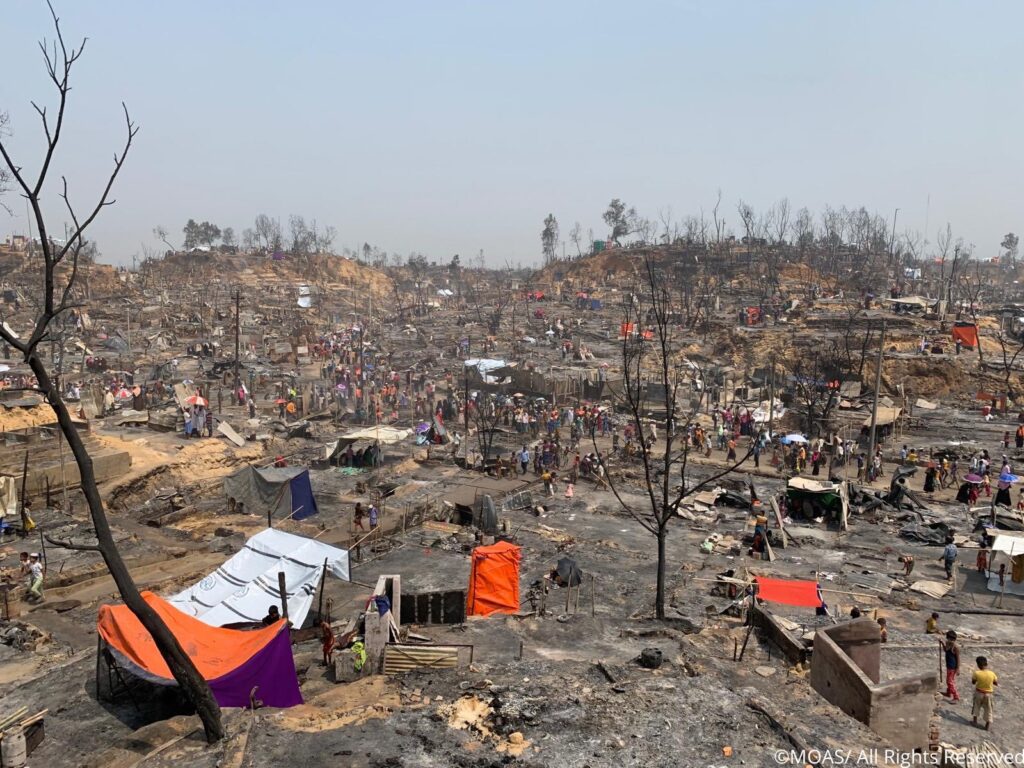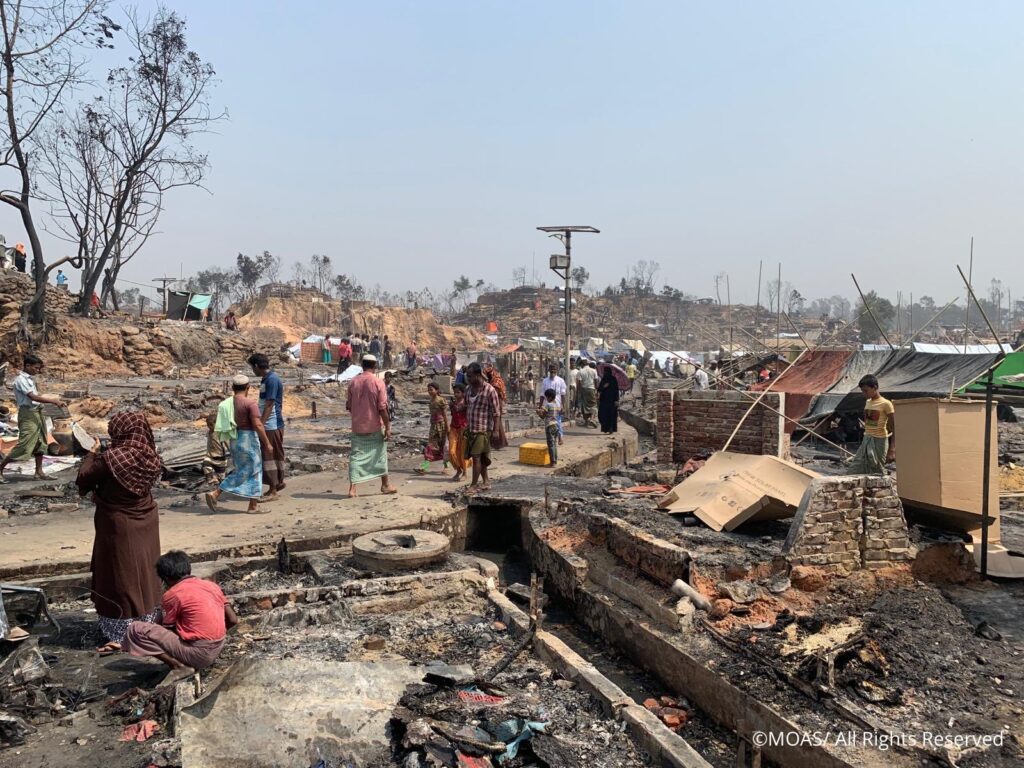We were at home when the fire broke out. I tried to dress my children and we ran out as soon as possible. The flames were very fast, and they engulfed everything in a few seconds, there was also a lot of smoke. Unfortunately, Kabir, one of my children, 4, was not at home at the time, he was out playing and was a victim of the fire. When we found him, his body was reduced to ashes. Sadly, other families in this camp also experienced this terrible tragedy and lost their children to the devastating fire. – Shahid
Bangladesh, 14th June 2021. FIRE-safety measures in the Rohingya refugee camps in Cox’s Bazar Bangladesh are to receive a major boost thanks to a new project by risk reduction experts from MOAS and their implementing partners Helvetas with support from the United Nations World Food Programme.
A pilot with support from the U.S. Agency for International Development (USAID) and WFP was conducted in April and May to identify and verify effective prototypes for fire preparedness and first response. Building on this, through a new project, believed to be the first of its kind, MOAS technical experts will seek to come up with innovative solutions to address the life-threatening dangers posed by fires in the over-crowded camps where over 860,000 Rohingya refugees live after fleeing violence and persecution in Myanmar.
The new project, supported by WFP, will specifically address two areas of crucial concern:
- Firefighter Safety – this will include command & control, dynamic risk assessments, fire behaviour, tactical decision making, defensive firefighting strategies, offensive firefighting techniques.
- First Strike Firefighting – this will address effective use of the most appropriate firefighting equipment.
The need for safe and effective firefighting in the camps could not be clearer. Analysis of reports from Cox’s Bazar Site Management Sector revealed a total of 172 fire-related events in the camps from May 2018 through February 2021; seven up to that point had occurred in 2021. Together, these blazes affected tens of thousands of individuals and destroying thousands of shelters and support facilities like health clinics, distribution points, and learning centers; over 550 alone of these were destroyed in the 11 January 2021 fire in the Nayapara Registered Refugee Camp, requiring the relocation of 3,500 individuals pending shelter reconstruction.
Then in March, the truly massive blaze so many had feared broke out. It claimed 15 lives, left over 500 injured and destroyed around 10,000 shelters, displacing around 45,000 refugees. For many of the Rohingya who had lost their homes during arson attacks on their villages in Myanmar, this second, fire-related destruction brought back previous traumas.
“We’ve seen first-hand the devastation fires can cause in the refugee camps here and elsewhere,” said a spokesperson for MOAS’ logistics and operations team. “The challenges of implementing effective fire-fighting measures in such an environment are considerable, but it is vital to find solutions for refugees’ safety and to ensure people who have already lost so much, do not lose what little belongings they have in fires.”
MOAS experts work across the world providing firsthand solutions in emergency and refugee settings. The organisation has already provided technical support to Helvetas to offer water-safety training to hundreds of Rohingya refugees and local communities and Bangladeshi fishermen in Cox’s Bazar aimed at mitigating risk of drowning – a key cause of fatalities in the area.
The camps in Cox’s Bazar, as in many such displacement settlements, are largely constructed from flimsy tarpaulin shelters with little or no space between them which makes it extremely easy for fire to spread, particularly during the hot, dry season. Most camps sprung up haphazardly as hundreds of thousands of refugees fled into Cox’s Bazar in just a few weeks.
The internationally-used Sphere Handbook on humanitarian standards notes in its shelter and settlement section that shelter interventions should be “well planned and contribute to the safety and well-being of affected people and promote recover”. However, experts stated that there are no guidelines published in Sphere for fire-fighting. There are for fire breaks, but given the cramped and unplanned nature of many of the camps in Cox’s Bazar, they have not been followed in the main.
The Bangladeshi Fire Authorities are responsible for tackling major blazes and the UN and other organisations working on the humanitarian response have created fire safety points throughout the camps with sand buckets and have provided basic fire-safety training to volunteers. However, the camps’ remote locations and cramped layout with extremely narrow passageways can make it time consuming and difficult to access with fire engines and larger pieces of firefighting equipment.
Meanwhile, while sand buckets can be useful for extinguishing smaller fires, once a blaze grows to any size there is little can be done to control it under the current system. The new project is aimed at finding safe and effective solutions that will support refugees to ensure more fires can be extinguished even before fire services arrive.
MOAS hopes the solutions it identifies for improvements and addressing gaps in fire-fighting methods and trainings in the Cox’s Bazar camps can contribute to fire-fighting initiatives in displacement camp settings worldwide.
MOAS director Regina Catrambone, thanked WFP for their support. “MOAS was founded with the goal of saving refugees from drowning in the Mediterranean and now specialises in direct action and innovative solutions to protect migrants from many dangers around the world. Thanks to support from WFP and the dedication and commitment of our implementing partners Helvetas we can now work to support the Bangladeshi Fire authorities and the refugees in reducing the terrible risk of fire in the Cox’s Bazar camps.”
Sheila Grudem, WFP Senior Emergency Coordinator, said:
“The fire in March was a devastating reminder of the fragility of the Rohingya refugee camps. The UN World Food Programme is the largest humanitarian organization saving lives and changing lives around the world. We’re proud to support innovative projects that will prevent disasters and respond when emergencies occur.”
Barbara Dietrich, Regional Coordinator Bangladesh, Laos and Myanmar at Helvetas, added: “Helvetas is involved in development cooperation and humanitarian response worldwide and is working with MOAS in Bangladesh. Thanks to the professionalism of MOAS and their technical support, Helvetas can thus contribute to saving lives.”
PRESS ENQUIRIES:
Francesca Pierpaoli
PR & Communications Officer
Tel. +356 79900097
[email protected]
_____________________________________________________________
About MOAS
MOAS is an international humanitarian organization founded by the Catrambone family in 2013 and dedicated to providing humanitarian assistance and services to the most vulnerable communities around the world. Since its inception, MOAS has reached hundreds of thousands of people through its activities. After several Search and Rescue missions in the Mediterranean Aegean and Andaman seas, MOAS expanded its operations to Bangladesh, to assist Rohingya refugees fleeing violence in Myanmar and the local host community. Today MOAS is currently also involved in several missions in Yemen and Somalia assisting the most vulnerable communities by delivering nutritional and medical aid. MOAS also operate in Malta with various projects to assist migrant communities. With the #SafeAndLegalRoutes campaign, MOAS is advocating to governments and international institutions to fight exploitative and dangerous migration routes and human trafficking by increasing safe and legal pathways of migration that exist on paper but are not sufficiently supported practice to allow the most vulnerable people to safely reach the countries of destination. MOAS has consultative status of Ecosoc and is member of the Malta Refugee Council.
Info: www.moas.eu


